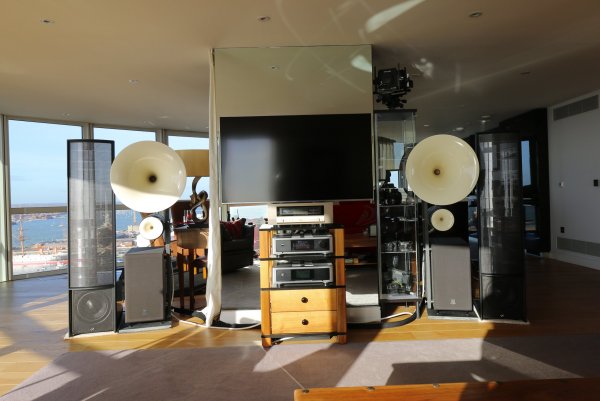Let me start out with the disclaimers... I'm a manufacturer with unorthodox views on this subject.
In this post I'm only going to look at room interaction; getting the first-arrival sound right also matters, especially when it comes to precise image localization, but that's a complex topic that is less closely tied to the particular loudspeaker type.
In a home listening room there are two competing sets of venue cues: The First Venue which is what's on the recording, whether natural or engineered or some combination thereof; and the Second Venue, which is the playback room. We want to perceive the First Venue cues and not perceive the Second Venue cues.
So let me give an example of how these two Venues might square off against one another:
Suppose you have Maggies and they are placed one foot in front of the wall. Your soundstage depth is severely constrained by the wall - if you are lucky, you might perceive a soundstage extending about two feet behind the speakers (twice the distance to the wall). So the Second Venue cues are dominating the soundstage depth.
Now let's move our Maggies out into the room about three feet. This makes a worthwhile improvement - now our soundstage can seem to extend as much as six feet behind the speakers, but it's still being dominated by the Second Venue.
So let's move 'em out even more, say five or six feet. On a good recording, the magic starts to happen: We start to perceive a soundstage depth which corresponds with the First Venue moreso than with the Second. The improvement is greater than what can be explained by a few additional milliseconds of delay on the backwave. We have crossed a threshold into the First Venue.
Maybe we don't have enough room to pull our Maggies out that far, so we experiment with aggressively absorbing the backwave. This may or may not be a net improvement, but it fails to convey the sense of immersion we got with five or six feet. This shows that the relatively late-onset backwave is presenting the First Venue cues in a way that our ears naturally resonate with... no pun intended.
What worked well in my little example was, 1) a relatively long time delay between the first-arrival sound and the strong onset of reflections (arrival of the backwave); and 2) those reflections are inherently spectrally correct (same frequency response as the front wave). I believe these general principles apply regardless of what kind of speakers we have.
So with an omni, if professional room treatment isn't an option, we'd want to position them well out into the room to avoid early reflections. You see, early reflections pull the image towards the reflection. Most speakers have a wide enough pattern that they interact fairly strongly with the side walls, increasing the apparent source width beyond the left and right speakers. Omnis placed too close to the wall behind them can have the same thing going on with the wall behind the speakers, increasing the width of stereo images between the speakers as well. The result can be unnatural sound images like acoustic guitars six feet wide. The solution is, distance from the walls OR professional room treatment. Padding the walls with foam (amateur room treatment) is not a good solution.
The reason we don't want to overuse absorption is this: The ear will pick out the reflections of a particular instrument and bundle them with the first-arrival sound to create a reverberant tail which conveys the acoustic space of the First Venue, or a good approximation thereof. Typically, absorption selectively removes the highs, so now those reflections are harder for the ear to identify as belonging to the first-arrival sound, so they start to become "noise" rather than "signal". There is a "sweet spot" to decay times which is worth shooting for, and ime a professional will do a much better job of getting there over a broad portion of the spectrum than an enthusiastic amateur.
With most conventional dynamic speakers we can expect strong sidewall interaction, so again unless we have a large room professional acoustic treatment makes sense, ideally re-directing the early same-side-wall reflections in a direction other than the sweet spot, so that that energy arrives considerably later but with its spectral content intact.
Horn speakers can be aimed to avoid early same-side-wall reflections altogether, which is imo desirable, and may be a solution worth considering. In my experience a good presentation of First Venue cues calls for a decent amount of reverberant energy, therefore in my opinion with horn speakers we want to preserve our relatively scarce and therefore precious reverberant energy by avoiding unnecessary absorption.
But consider the foregoing to be merely a collection of generalizations, and the devils are in the details, and clever designers can be on a first-name basis with said devils. In other words, I suggest evaluating speakers based on their individual merit or lack thereof, rather than based on generalizations.
















